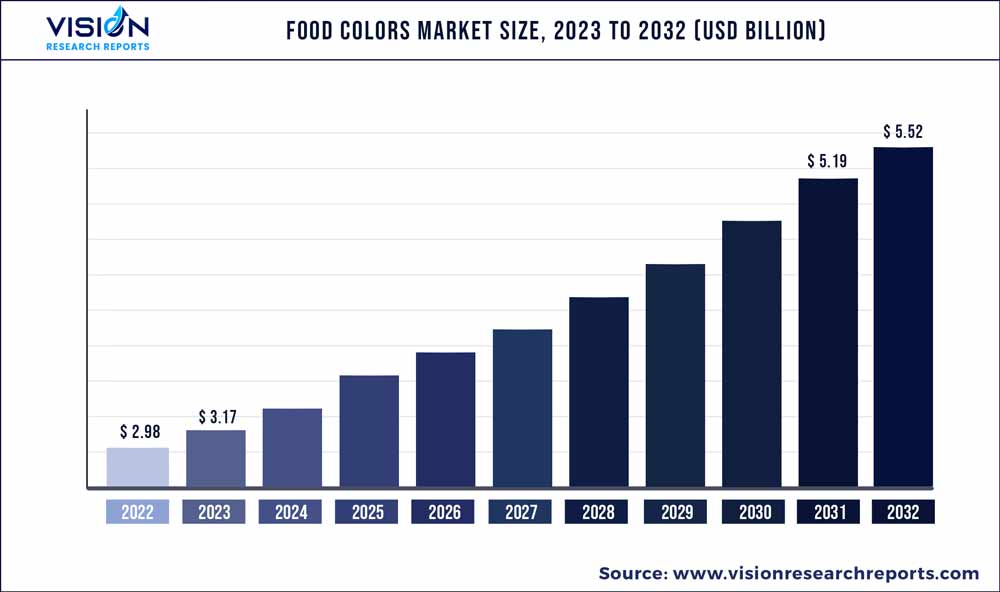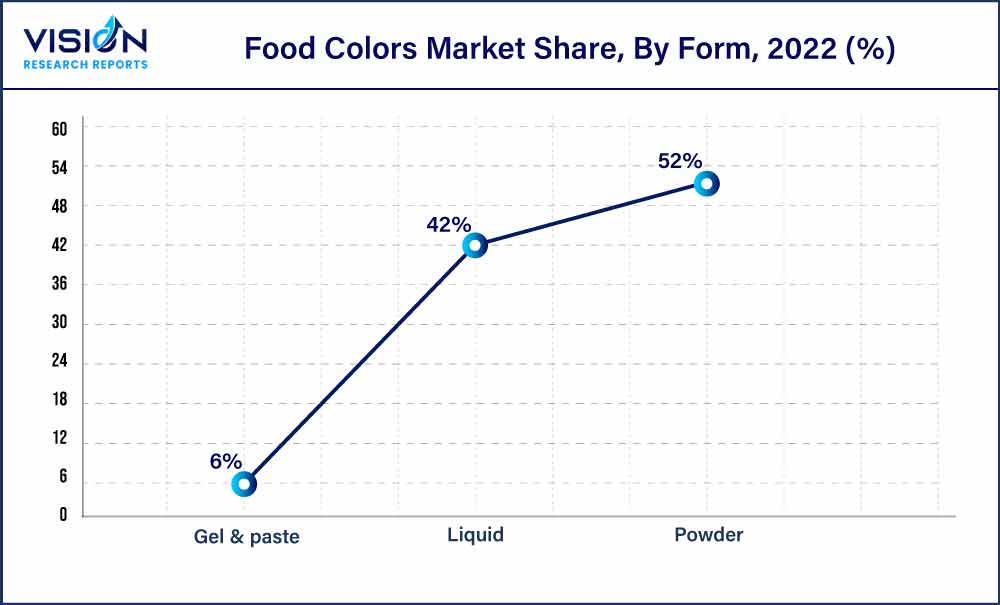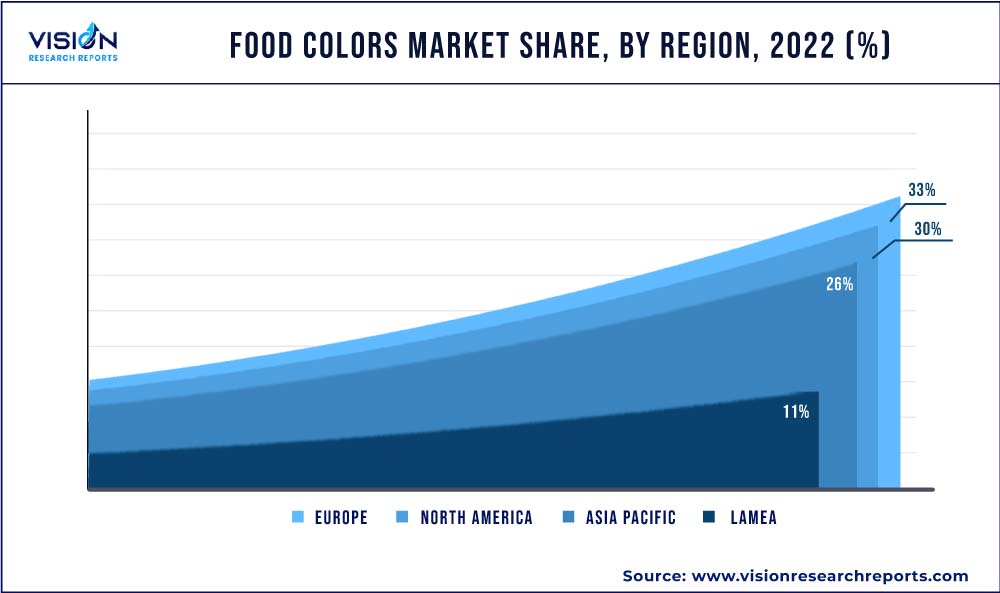The global food colors market was estimated at USD 2.98 billion in 2022 and it is expected to surpass around USD 5.52 billion by 2032, poised to grow at a CAGR of 6.36% from 2023 to 2032. The food colors market in the United States was accounted for USD 435.2 million in 2022.

Key Pointers
Report Scope of the Food Colors Market
| Report Coverage | Details |
| Revenue Share of Europe in 2022 | 33% |
| CAGR of Asia Pacific from 2023 to 2032 | 7.26% |
| Revenue Forecast by 2032 | USD 5.52 billion |
| Growth Rate from 2023 to 2032 | CAGR of 6.36% |
| Base Year | 2022 |
| Forecast Period | 2023 to 2032 |
| Market Analysis (Terms Used) | Value (US$ Million/Billion) or (Volume/Units) |
| Companies Covered | BASF; Cargill; CHR Hansen; Danisco; DD Williamson; DSM; GNT Group; Lycored Ltd; Naturex |
Growth in the global population is expected to result in increased demand for food & beverage products, which is further likely to drive the demand for the product over the forecast period. The burgeoning food & beverage industry in BRICS in light of the increased domestic consumption is anticipated to be a major driving factor for the market over the forecast period. The increasing need for convenience foods due to the growing consumer knowledge about products with an exotic and traditional taste is predicted to further promote the growth of the market in the next few years.
Over the past few years, governments of Spain and Germany have launched and successfully implemented numerous campaigns to promote healthier lifestyles by introducing innovative health products to reduce obesity, cholesterol, and diabetes. This trend is expected to play a crucial role in the promotion of natural food colors in consumables.
The market is expected to exhibit a low threat of new entrants on account of extensive portfolio offered and distribution network operated by existing players, which results in a high entry barrier for the new entrants. Besides, the high switching cost for the buyers makes it difficult for new players to gain a significant market share, thereby lowering the threat of new entrants.
Concerns raised by consumers regarding the use of natural carmine extracted from cochineal insects are encouraging the manufacturers to seek other alternatives. With LycoRed producing its Lyc-O-Beta carotene orange color through the fermentation of the Blacksiea trispora fungus, Chr. Hansen is also trying to manufacture carmine through a similar process. Companies are also searching for alternatives owing to the fluctuating prices of carmine.
Type Insights
By type, the natural dominated the market and accounted for revenue share of more than 40%. The primary driver is the growing consumer preference for natural and clean-label products. Consumers are increasingly seeking out food products that are free from synthetic additives and artificial colors, as they are perceived as healthier and more wholesome. This shift in consumer behavior has prompted food manufacturers to reformulate their products using natural food colors derived from plant, fruit, and vegetable sources.
The synthetic segment is anticipated to exhibit CAGR of 5.63% during the forecast period (2023-2032) in terms of revenue. The market for synthetic food colors is expected to grow on account of growing product use by consumers across the developing economies. Besides, the demand for synthetic colors, such as green and blue, is expected to be driven primarily by their use in the beverage manufacturing industry. However, rising substitution by natural colors may hamper industry growth.
Form Insights
By form, the powder form dominated the food colors market and accounted for revenue share of 52% in 2022. The powder form offers convenience and ease of use. It can be easily stored, measured, and mixed into various food products, making it a versatile choice for both industrial and home cooking applications. Powdered food colors also tend to have a longer shelf life compared to liquid or gel forms, providing better stability and reducing the risk of spoilage.

The liquid form is anticipated to exhibit the highest revenue-based CAGR of 6.64% during the forecast period. They are highly concentrated and can achieve deep, rich hues with just a few drops. This is particularly important in the food industry, where appealing visual presentation plays a crucial role in consumer perception and purchasing decisions. Liquid food colors allow for precise color control, enabling chefs and food manufacturers to achieve the desired shade and tone in their products.
Source Insights
By source, the plant, animal and insect segment dominated the market and accounted for revenue share of 60% in 2022 and is projected to maintain its lead over the forecast period. The driving forces behind the growth of plant, animal, and insect source in the food color market include consumer demand for natural and clean label products, concerns over synthetic color additives, the emphasis on sustainability, and cultural preferences for traditional ingredients. These factors are shaping the industry and encouraging manufacturers to explore and incorporate natural sources into their food color formulations.
The microbes source is poised to expand at the CAGR of 5.83% by revenue from 2023-2032. Microbes offer a wide range of vibrant and diverse color options, enabling manufacturers to create visually appealing food products. These natural colors derived from microbes can be used to replace synthetic colorants, which have raised concerns regarding their safety and potential health risks.
Application Insights
By application, the bakery and confectionery dominated the market in 2022 with 30% share of the overall revenue. The bakery and confectionery application is driving the food color market by offering opportunities for creativity, visual appeal, and customization. As consumers increasingly prioritize the visual aspect of food products, the demand for food colors in the bakery and confectionery industry is expected to continue to grow.
The beverage application is poised to expand at the highest CAGR of 7.05% by revenue from 2023-2032. Beverages, including soft drinks, energy drinks, juices, and alcoholic beverages, have become an integral part of modern lifestyles, with increasing consumption worldwide. As consumers seek more visually appealing and aesthetically pleasing beverages, the demand for food colors to enhance the appearance of these drinks has significantly risen.
Regional Insights
Europe dominated the market in 2022 with 33% share of the overall revenue along with the CAGR of 5.86% during the forecast period 2023-2032. Robust bakery and confectionary industry in Europe coupled with growing consumer demand is expected to have a positive impact on the market growth in the region over the forecast period. Also, stringent regulations concerning the use of artificial food colors are expected to strengthen the natural food colors market in Europe.

Demand for food colors in North America accounted for a market share of over 28.63% in 2022 and is expected to witness substantial growth over the forecast period. The increasing popularity of processed and packaged food products in North America has also contributed to the growth of the food color market. Processed foods often require the addition of food colors to enhance their appearance, as they may lose color during processing or lack visual appeal. As consumers continue to seek convenience and a wide variety of food options, the demand for food colors to improve the visual appeal of processed foods remains high.
The market in Asia Pacific is poised to witness substantial growth over the forecast period, registering a CAGR of 7.26% in terms of revenue. The Asia Pacific exhibits high adoption of nature-identical products driven by superior product properties such as uniform color and comparatively lower cost than natural food colors. Also, the high adoption of the product in the production of alcoholic and non-alcoholic beverages is expected to drive the market growth.
Food Colors Market Segmentations:
By Type
By Form
By Source
By Application
By Regional
 Cross-segment Market Size and Analysis for
Mentioned Segments
Cross-segment Market Size and Analysis for
Mentioned Segments
 Additional Company Profiles (Upto 5 With No Cost)
Additional Company Profiles (Upto 5 With No Cost)
 Additional Countries (Apart From Mentioned Countries)
Additional Countries (Apart From Mentioned Countries)
 Country/Region-specific Report
Country/Region-specific Report
 Go To Market Strategy
Go To Market Strategy
 Region Specific Market Dynamics
Region Specific Market Dynamics Region Level Market Share
Region Level Market Share Import Export Analysis
Import Export Analysis Production Analysis
Production Analysis Others
Others